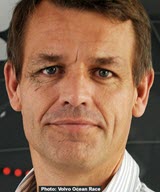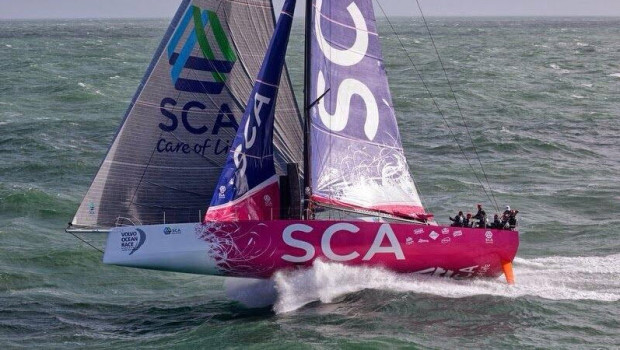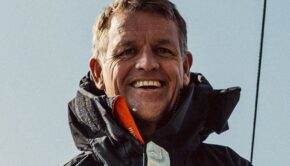Knut Frostad: Organizing the 2014-15 Volvo Ocean Race
Published on September 29th, 2014
 With the last Volvo Ocean Race drawing to a close, CEO Knut Frostad announced in June 2012 that the Volvo Ocean 70 class would be retired, and the race would enter a new era to help reduce the cost of mounting a campaign and hopefully build the fleet size for future editions.
With the last Volvo Ocean Race drawing to a close, CEO Knut Frostad announced in June 2012 that the Volvo Ocean 70 class would be retired, and the race would enter a new era to help reduce the cost of mounting a campaign and hopefully build the fleet size for future editions.
Beginning with the 2014-15 race, rather than use a design rule, teams would all race the one design Volvo Ocean 65, a boat with near similar polars as its predecessor, but also to include technical enhancements to improve safety and communications.
With the first boat launched in September 2013, a fleet of seven teams are now training in anticipation of the October 4 start. Knut shares with Scuttlebutt what it took to get this edition organized…
When the project got underway, we determined that the maximum capacity we had was to produce eight boats. We were never 100% confident, but based on the discussions I was having at the time with various potential sponsors, we felt that we could fill all the boats we could build. But it was never certain; you have to take some risk to be successful.
However, the build schedule had the eighth boat being launched by mid-July 2014. The feedback we got from most of the competitors was that would be too late to begin their training, so our plan regarding building boat eight was based on whether we had a firm buyer at the beginning of construction. With six months of building time, and without a team ready to start the boat, we made the decision to not proceed with the eighth boat just after last Christmas.
So we knew at the start of this year we were planning for a seven boat race, and we’d have to be happy with that. In hindsight, we were fortunate to confirm in August the entry for the seventh boat.
To be frank, we took a considerable amount of risk when we started the Volvo Ocean 65 project for the 2014-15 race, but we knew we needed to take the risk to get ahead of the organization of the teams. The boats couldn’t be built at the same time as teams formed; we knew we had to start building boats before we had confirmation from teams.
The role we played was that we were providing financing to Green Marine to be able to design, build the tools, purchase materials, and even for some of the boats, part of the production. As soon as the teams were confirmed, they’d join in a purchase agreement with Green Marine and take over ownership of the boat. All seven boats are owned by the teams; we do not have any ownership in the boats.
However, our plan is to use these boats in this edition and the next edition of the Volvo Ocean Race. If any of these teams decide not to do the next race in 2017-18 and they seek to sell the boat, we have the right to purchase back the boats to insure that it stays within this plan.
There were six teams in the last edition, with some unevenness among the boat designs. For this race, we have seven strong teams that all have an equal chance to win. I don’t know all their budgets, but of the five teams I do know, their budget range is between 9 and 12.5 million Euros over two years.
In Part 2, Volvo Ocean Race CEO Knut Frostad discusses the involvement of race organizers in sponsor recruitment.
To get seven teams on the start line, our organization was very involved in helping assemble almost every team.
Probably the team we were least involved in was Team SCA as they were organized by Atlant Ocean Racing, who has two previous Volvo Ocean Race victories behind them with EF Language in 1998 and Ericsson Racing Team in 2009. But all the other teams we were involved in many stages, primarily in pitching to the sponsors but also in negotiating and even meeting many of the potential sponsors a lot of times before they would decide.
In the three years I have been in charge of the Volvo Ocean Race, our involvement in sponsor procurement increases with each addition. We now see a trend for sponsors to talk with us before they start talking to a sailing team.
Our involvement in sponsor recruitment is not because we are the only one that can do it, but for a sailing team that goes to a sponsor, we provide a lot of assurance and value in the negotiations. As race organizer, we are sitting around the table and delivering part of the return for the sponsor.
The sponsor looks at the sailing team, and knows that they will be the ones sailing the boat and trying to win the race for them, and will be the ones in the media representing them. But we are the ones that will be delivering the event. We are the ones that will be delivering the hospitality and race villages and television and media production. So as the event organizer, we can give a lot of assurances as we are a large and active organization with stable ownership. So for the sponsor, we help to reduce what they may see as their risk. They are able to talk with us before they decide to join the race.
Ideally, the teams and sponsors would simply meet and come to us, but the reality is that sponsorship sales today is getting more and more professional. The days when CEOs who had sailing boats would make, perhaps, irrational decisions to support teams, based on their own emotional engagement, are over. Today you can be a CEO who loves sailing, but it is the marketing and commercial teams that vets out the details to make the decision.
When you do the pitches and presentation, you are meeting with a very professional partner that wants to see the full scope of the event. They want to see what they get for the money, they want to see the financial history and forecasts, and this is all information that as organizer, we can provide. There are very few sailing teams that have a fully capable commercial side that can make this kind of presentation.
Most of the teams are start-stop projects which close the books when a race is done, without much if any continuity before the next project. So I see our involvement as a good way to make it work, and the closer we work with the teams, the better it is for the sponsors.
In Part 3, Volvo Ocean Race CEO Knut Frostad discusses what was required to successfully recruit team sponsors.
In our work to recruit team sponsors, one of the big lessons has been in the customization of our presentations. Every time we are successful, it is because we worked extremely hard before the pitch to make sure what we present is absolutely suited for this company and what they are trying to achieve by doing the race. The customization of each presentation is key.
I haven’t seen one sponsor in the last ten years that buys into this event simply based on generic figures and presentation. They want to know exactly why it will work for them, why it will hit their market, why their customers will like it, why their brand will be better. We need to have the answers to their needs and questions for the presentation to have any chance.
In the sailing world, there is a huge underestimation of the amount of work required to find 10 million dollars. It is quite interesting, as we have a lot of projects that come in the door, lots of teams have contacted us or sailors who have contacted us, and they have a sponsor lead, or the know someone that can help get a sponsor. I think we counted more than 150 different projects that approached us for the 2014-15 race. Certainly some were in the dreamer category, with no realism at all, but most never make it because they really don’t understand how much effort is required to find 10 million dollars.
Even with a well-known property, such as a prominent sports team in an organized professional league such as baseball or basketball, it is a big project to land a large sponsorship. And for a sport that is not widely known like sailing, it is so much harder. Normally we spend three to four months of research to develop a presentation pitch for one specific company. We have to be spot on to their needs, and can’t leave anything for chance. We need to be highly professional, as even if we don’t fully meet their objectives this time, we want them to know that we are a group to work with in the future.
For our organization, preparing a sponsor pitch is a full-time job for quite a few people. Too many sailing projects go about it part time, maybe put some slides together and gather some facts, and they wonder why they get turned down. Sponsorship failure is not because sailing is not a big enough sport. That’s not true as sailing is a fantastic outlet. The reason pitches have a negative outcome is typically because they are not executed properly.
Here are the main sponsors for the seven race teams:
Abu Dhabi Ocean Racing (skipper, Ian Walker): Abu Dhabi is the capital and the second most populous city in the United Arab Emirates and also capital of the largest of the UAE’s seven member emirates. The second leg of the race extends 6125nm from Cape Town in South Africa to Abu Dhabi.
Dongfeng Race Team (skipper, Charles Caudrelier): Dongfeng Commercial Vehicle Company Limited is a leading manufacturer for producing medium and heavy duty vehicles in China, specializing in trucks, buses, chassis and in providing a variety of parts and components for commercial vehicles, like engines, axles and transmissions.
MAPFRE (skipper, Iker Martinez): Mapfre is the leading insurance company in Spain with offices throughout the race route.
Team Alvimedica (skipper, Charlie Enright): Alvimedica is a Turkey based cardiovascular and vascular minimal invasive medical devices company.
Team Brunel (skipper, Bouwe Bekking): Headquartered in The Netherlands, Brunel is an international group that specializes in flexible deployment of professionals in the field of Engineering, Marketing & Communication, Healthcare, IT, Legal, Finance and all disciplines in the Oil & Gas industry.
Team SCA (skipper, Sam Davies): Founded in Sweden, SCA is a leading global hygiene and forest products company that develops and produces sustainable personal care, tissue and forest products.
Team Vestas Wind (skipper, Chris Nicholson): Vestas Wind Systems A/S is a Danish manufacturer, seller, installer, and servicer of wind turbines, with manufacturing plants in Asia, Australia, Europe, and North America.
Background: The 2014-15 Volvo Ocean Race starts October 4 and will take the 7-boat fleet to 11 cities in 11 countries – Spain, South Africa, United Arab Emirates, China, New Zealand, Brazil, United States, Portugal, France, The Netherlands, and Sweden – and will require the teams to cover 38,739 nautical miles over nearly nine months. It will be the first edition using the new one design Volvo Ocean 65 racing boats. Race website: http://www.volvooceanrace.com/en/home.html









 We’ll keep your information safe.
We’ll keep your information safe.